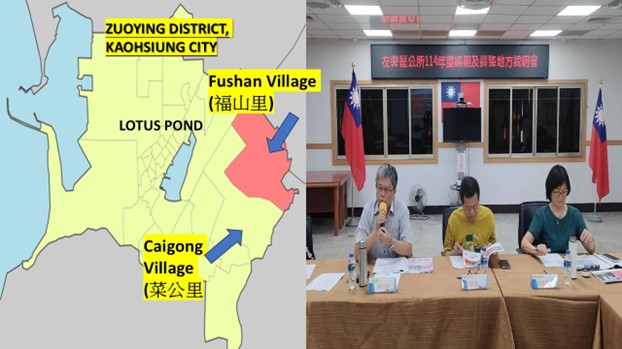Above left: A Wiki map of Zuoying District, Kaohsiung City. Right: Zuoying District directors outline on consolidation plans during a Sept. 17, 2025 meeting. Image via Kaohsiung City Govt. policy details to the village chiefs
NOTE: See below for a “deep dive” into how Taiwan is administered
KAOHSIUNG, Taiwan — Officials in Kaohsiung’s Zuoying District (左營區) are moving ahead with plans to merge smaller administrative villages, saying the changes will make government services more equitable and efficient.
Expats living in Taiwan may not realize what “village” they live in. Village names don’t appear on Alien Resident Certificates (ARC) or Permanent Resident Certificates (APRC), but they are easy to look up online, or simply by noticing the Chinese signs around your neighborhood.
Taiwan’s administrative system is layered. At the top are cities (市 shì) and counties (縣 xiàn). Cities like Kaohsiung (高雄市 Gāoxióng Shì) are divided into districts (區 qū)—Kaohsiung has 38. Districts are further divided into urban villages (里 lǐ). In counties, districts don’t exist; instead, counties are divided into townships (鄉 xiāng or 鎮 zhèn), which are broken down into rural villages (村 cūn). The two terms 里 and 村 both translate as “village,” but 里 refers to urban neighborhoods while 村 refers to rural ones.
The Sept. 17, 2025, public meeting in Kaohsiung followed earlier sessions on splitting larger villages, which drew strong support from residents. Officials said smaller villages also need adjustments, citing population disparities of more than 100-to-1 between Zuoying’s biggest and smallest.
District Director Su Ping-fu (蘇平福) emphasized that household registration, property, and schooling rights would remain unaffected. “Village mergers mean more balanced resources and stronger services,” Su said.
Legislative aides for lawmakers Lee Po-yi (李柏毅), Chen Ching-hui (陳菁徽), and Lai Jui-lung (賴瑞隆) attended, along with staff representing multiple city councilors. Some village chiefs voiced support for keeping the status quo but said they would comply if the city proceeds.
Councilors Huang Wen-chih (黃文志) and Lee Ya-fen (李雅芬) called for protections for village chiefs’ rights during the process. Su said the plan balances population realities with local history while acknowledging the service of village leaders. He added that the goal is to ensure resources meet residents’ needs and improve the quality of public services.
A DEEPER LOOK: Taiwan’s Village System & What It Means for You.
Case Study: Zuoying District (左營區)
In Kaohsiung’s Zuoying District (左營區 Zuǒyíng Qū), villages can be enormous by population standards.
At the other end of the spectrum, some villages in Kaohsiung have many fewer residents. Zhongbei Village in Zuoying, for example, has a population of just 550 – showing the huge population disparities between the largest and smallest.
Why Villages Matter
A village (里 or 村) is essentially your neighborhood-level administrative hub. Each has an elected village chief (里長 lǐzhǎng), chosen every four years. Chiefs receive a subsidy of NT$45,000 per month for expenses such as transportation, stationery, and utilities. Their duties include:
The size of a village affects resources: larger villages often receive more funding and can exert greater influence on city policy.
Historical Roots
This system dates back to the Japanese colonial period (1895–1945), when neighborhoods were organized into administrative units called hō (保). After 1945, when Taiwan came under the Republic of China, the names changed but the concept largely remained the same.
Modern Debates: Splits and Mergers
As of today, Kaohsiung has 38 districts and 890 urban villages, second only to New Taipei City (新北市 Xīnběi Shì), which has 29 districts and 1,032 urban villages.
In Zuoying District, officials are debating whether to split large villages like Fushan or merge smaller ones to balance population disparities and improve efficiency.



